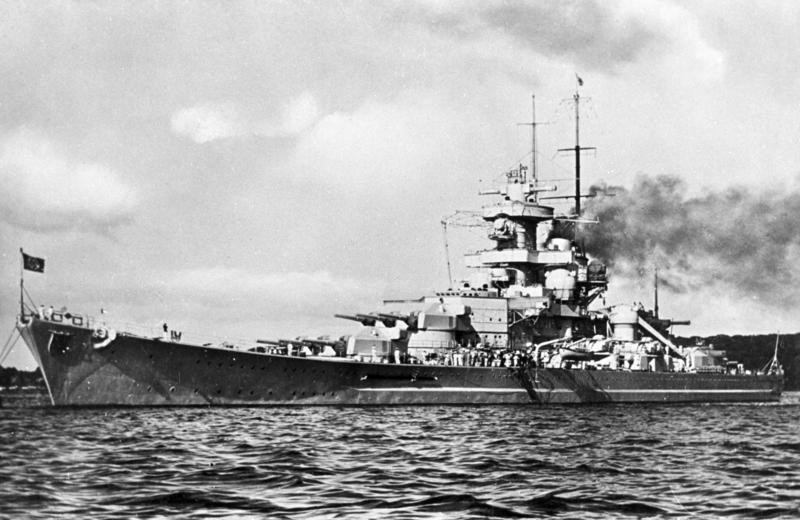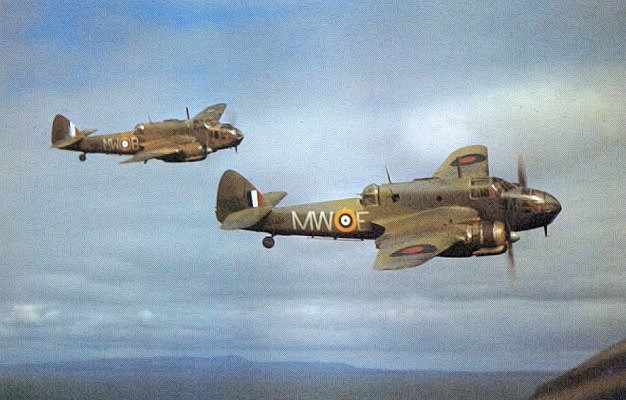naval-history.net
wikipedia
After conclusion of Operation Berlin (commerce raiding in Atlantic between February-March 1941 during both German battleships sunk or captured 22 merchant ships totalling almost 90.000 GRTs within seven weeks and caused quite a worry in British Admiralty) Admiral Lutjens commanding both German battleships Scharnhorst and Gneisenau decided to sail to German occupied Brest harbour to replenish their suppies , do maintenance work before their next big commerce raiding operation in Atlantic.
Which never came. As soon as Scharhnhorst and Gneisenau reached Brest harbour in western France in 22 March 1941 , RAF Coastal Command (with bases in range at Southern England) started heavy air raids to put both German battlewagons off action.

The first attack took place on the night of 30–31 March, and a second occurred on 4–5 April. During this second raid, a 227 kg (500 lb) armor-piercing (AP) bomb narrowly missed the ship. As a result of the attacks, the ship was moved out of the dry dock and moved to the harbor. On 6 April, Gneisenau was attacked by British torpedo bombers, which managed to score a single hit that damaged her severely. The Bristol Beaufort that struck the ship was piloted by RAF Flying Officer Kenneth Campbell (VC).

He flew his Bristol Beaufort through the gauntlet of concentrated anti-aircraft fire from about 1000 weapons of all calibres and launched a torpedo at a height of 50 feet (15 m).
The attack had to be made with absolute precision: German battleship Gneisenau , scourge of Allied merchantmen in Atlantic for last couple of months , was moored only some 500 yards (460 m) away from a mole in Brest’s inner harbour. For the attack to be effective, Campbell would have to time the release to drop the torpedo close to the side of the mole. That Campbell managed to launch his torpedo accurately is testament to his courage and determination.
Generally, once a torpedo was dropped, an escape was made by low-level jinking at full throttle. Because of rising ground surrounding the harbour, Campbell was forced into a steep banking turn, revealing the Beaufort’s full silhouette to the gunners. The aircraft met a withering wall of flak and crashed into the harbour. The Germans buried Campbell and his three crew mates, Sergeants J. P. Scott DFM RCAF (navigator), R. W. Hillman (wireless operator) and W. C. Mulliss (air gunner), with full military honours. His valour was only recognised when the French Resistance managed to pass along news of his brave deeds to England
The torpedo struck German battleship Gneisenau in the vicinity of the rear main battery turret. Some 3,050 t (3,000 long tons) of water flooded the ship and caused a 2 degree list to starboard. The flooding also disabled several components of the ship’s propulsion system. The explosion caused significant destruction to the side plating as well as the starboard and centerline propeller shafts. The concussive shock also caused widespread damage to the ship’s electronic components. A salvage tug came alongside to assist in the pumping effort. The ship was severely damaged below the waterline and was obliged to return to the dock whence she had come only the day before; she was put out of action for six months, lessening the threat to Allied shipping crossing the Atlantic. As a result of this the attack, Gneisenau returned to the drydock for repairs for more than six months.

Three days later, on the night of 9–10 April, several British Halifax bombers dropped around 25 t (25 long tons) of 227 kg AP bombs on the ship, four of which hit. All four hit the starboard side of the forward superstructure. Two of the bombs exploded on the main armor deck while the other two failed to detonate. The attack killed 72 initially from German battleship crew and wounded 90, of whom 16 later died of their injuries. The bombs slightly damaged the main armor deck and caused some structural damage on the starboard side. It was decided to make alterations to the ship while she was drydocked for repairs; these included the installation of fourteen additional 2 cm anti-aircraft guns and six 53.3 cm torpedo tubes amidships. The aircraft hangar was rearranged, and the catapult that had been mounted on top of it was removed. The length of repairs and modifications precluded participation in Operation Rheinübung , the sortie by the new battleship Bismarck in May 1941.
NOTE : Bravery of this attack which put a German battleship out of action for more than six months and Victoria Cross earning , should be known more like Italian underwater raid in Alexandria (in this case RAF Beaufort crew sacrificed themselves)